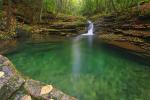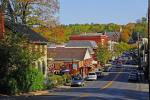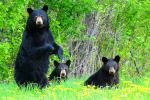Magazine
A professional photographer’s advice for capturing
your kids Kathy Beaver of Kathy Beaver Photography
generously offers Simply Appalachian readers a number
of tips for taking your own back-to-school photos of
your children.
Swimming holes dot the Appalachian Mountain chain.
There are hundreds if not thousands of swimming holes,
in every Appalachian state. Some of these swimming
spots are popular, while others are inaccessible to
anyone but a dedicated backpacker. Some maybe haven’t
even been discovered yet.
Lewisburg, West Virginia, is an unassuming little town
stuck in time in the Greenbrier Valley of the
Allegheny Mountains. Founded in 1782 by General Andrew
Lewis (who fought in the Revolutionary War), Lewisburg
today has been named one of the “coolest small towns
in America.” Its charm lies in its obvious history and
the natural beauty of the surrounding mountains. You
can expect to enjoy both when you visit.
The Appalachian region has a rich and varied past,
starting in the early settler days. The Appalachian
Mountains got in the way of the pioneers of the area;
the hilly terrain presented a tough barrier to those
wanting to head west. It wasn’t until Daniel Boone was
commissioned to build what we now call the “Wilderness
Road” in 1779 through Cumberland Gap that people begin
to move westward and settle in the mountains.
You may think that California and the Far East are the
places most at risk for earthquakes, but the mountains
of the Appalachians have had their share of
earth-shattering quakes throughout history. And
researchers predict the Eastern mountain range is ripe
for more. A magnitude 2.4 earthquake hit the mountains
of North Carolina around Boone and Blowing Rock in
August 2014, and an earthquake of magnitude 2.9 struck
the same location in August 2013. A magnitude 5.8
quake shook the mountains of Virginia in 2011. Roanoke
Rapids and Lenoir, NC, experienced earthquakes in June
2015, at magnitudes of 2.3 and 3.0 respectively.
Native and transplant Appalachians alike agree that
the best way to go through life is to share. We share
our bounty and our hand-me-down recipes. We share the
road and share the trails. And, to stay safe and
mountain-friendly, we share our space with humans and
critters alike -- including bears. You may see bears
roaming mountain cities and towns, but that’s usually
only by accident or when the bears are hungry or
thirsty. They are great hunters and foragers, so, more
often than not, their appearances in your yard or in
the neighborhood park are due mainly to drought or
food shortages in their forest habitats.
Along the Appalachian Trail, you can encounter many
types of animals and birds. While smaller animals are
more commonplace, clever foxes usually remain out of
sight. It’s not that they aren’t curious; it’s that
they’re cautious. Appalachian foxes have grown wary of
humans. You still may surprise a fox in the wild, but
they’ll seem more afraid of you than you are of them.
The Appalachian Mountains provide a home to one of the
most diverse eco-systems in the world. There actually
are more than 10,000 different animal and plant
species residing here. Organisms such as fungi and
salamanders are most diverse in Appalachia. Mosses
represent another diverse species that thrive in the
area. Moss is a small flowerless green plant that
doesn’t have any roots. It grows in long, low carpets
or rounded cushions in damp habitats found all
throughout the Appalachian Mountain range. Moss
reproduces by releasing spores from stalked capsules.
- ‹ previous
- 6 of 21
- next ›




0a33.jpg?itok=qZsgFkop)



9645.jpg?itok=hyEH8u5u)